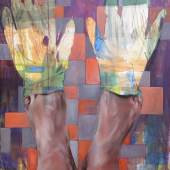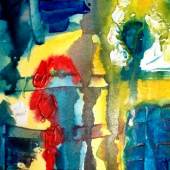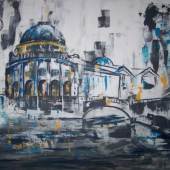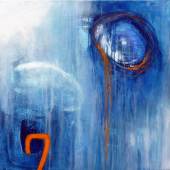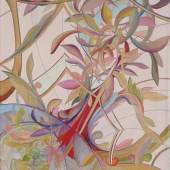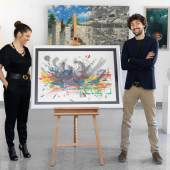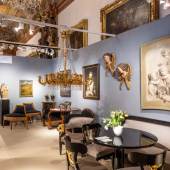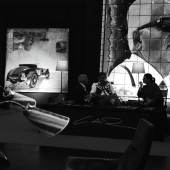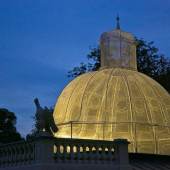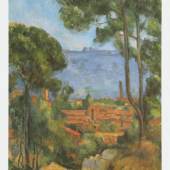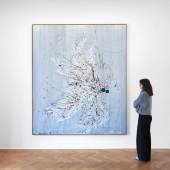Ropac Salzburg
Hans Josephsohn
-
Ausstellung23.07.2024 - 31.08.2024
This first exhibition of Hans Josephsohn’s (1920–2012) works at Thaddaeus Ropac presents sculptures and reliefs from the mid-1970s to the early 2000s, tracing the Swiss artist’s stylistic development over the course of three decades, and placing an emphasis on his late work. Josephsohn’s practice is characterised by his lifelong preoccupation with the human form as the starting point for his art. Throughout his career, he developed a wholly unique visual language, pushing the boundaries of figurative representation and placing emphasis on the very substance of the human form.
The textured surfaces are testament to the unmediated relationship between Josephsohn’s hands and the materials of the forms he sculpted, and often, traces of the artist’s fingermarks are visibly embedded in the works. Crafted from plaster and then cast in brass or bronze, his sculptures are raw, with roughly finished, haptic surfaces. Despite the ‘humanness’ inherent in all of his sculptures, at times the work’s surfaces are reminiscent of the natural world, evoking rugged rock formations. His fellow sculptor William Tucker has written: ‘What moves me most with Josephsohn is his persistence, his patient devotion to the everyday task of building sculpture with the humblest of materials – with small amounts of plaster added over time, hourly, daily, every month and every year of his life. […] In Josephsohn’s sculpture, both material and image merge.’
The artist worked primarily from models and his sculptures carry the impressions of this human contact. ‘Hans Josephsohn’s interest in the character of people was of vital significance for his creative work as an artist,’ states Ulrich Meinherz, Managing Director of the Kesselhaus Josephsohn in St. Gallen, where the artist’s estate is located. ‘As abstract and far removed as his sculptures may be from their natural appearance, the starting point was always the direct individual opposite him.’ Upon completion, Josephsohn often named his sitters in the titles of his sculptures.
During the 1970s, Hans Josephsohn’s depictions of the human body were still firmly rooted in figuration, bearing distinguishable facial features and body shapes. The earliest work in the exhibition, Untitled (Ruth) (1975-78), shows a female half-figure, her head and shoulders upright and her arms clasped in front of her body. Despite the figure’s striking sensuousness, Josephsohn’s tactile treatment of the surface disrupts the work’s representational quality, imbuing the sculpture with a sense of universal humanity.
From the 1980s to the 2000s, the primary focus of the exhibition, Josephsohn’s images of human beings allude to the body with increasing subtlety. The distinction between heads and half-length figures becomes increasingly fluid and the surface of these works from his late period is more porous; the natural proportions increasingly distorted. The abstracted volumes are defined by a powerful corporeality that emphasises the very substance of the human form, resounding with a timeless quality. Udo Kittelmann has stated: ‘Hans Josephsohn does not seek contemporaneity, but rather permanence.’ On the subject of his continual move towards abstraction the artist has remarked: ‘I simply wanted to get to the heart of the matter and didn’t want to be held back by the external impressions of nature.’
In Josephsohn’s practice reliefs play a central role in all phases of his artistic development. He has stated: ‘The reliefs come in some way from life – without meaning to sound too dramatic: they have a personal origin. So when something has happened [in my life], I’ve made reliefs in the atelier. And this has brought me catharsis.’ In contrast to his solitary depictions of individuals in his freestanding sculptures, the scenic surface allowed the artist to place multiple figures in relationship with each other – thus providing a space for Josephsohn’s contemplation on his own experiences of human connection. By adding an almost narrative quality to these explorations of interpersonal interactions, Josephsohn oscillates between lived experience and fictionalisation. ‘Josephsohn’s perception of self is shaped above all in his interpersonal day-to-day experiences; these experiences are continually and directly reflected in the reliefs,’ writes Ulrich Meinherz. Transcending mere representation, Josephsohn’s approach to representation can be understood as deeply personal investigations of the human condition.
This is art that will endure, for it recapitulates sculpture’s ancient function to memorialise, to console, and to celebrate human resilience. — Jackie Wullschläger, art critic
-
27.07.2021 - 31.07.2021Mit dem GALLERY WEEK_END 2021 erhält die Kulturszene Salzburgs ein neues Veranstaltungs-format,...
-
23.03.2024 - 01.04.2024Die Messe für Kunst, Antiquitäten und Design gehört zum österlichen Salzburg wie die Palmbuschen...
-
14.10.2022 - 16.10.2022Im Messezentrum Salzburg laufen die Aufbauarbeiten für die 18. Auflage der Internationalen...
-
Die Galerie der Stadt Salzburg im Ausstellungspavillon/Vogelhaus/Mirabellgarten diente über...
-
Der deutsch-französische Krieg beeinflusst natürlich auch das künstlerische Leben...
-
18.05.2024 - 20.07.2025Created in the artist’s studio north of Salzburg, this new series of paintings and ink...
-
21.12.2024 - 01.03.2025Diese Ausstellung präsentiert eine Auswahl von Skulpturen Hans Josephsohns (1920–2012), die...
-
11.01.2025 - 22.02.2025The exhibition Sculpture Nails at Thaddaeus Ropac Paris Marais highlights Sylvie Fleury’s...
-
25.01.2025 - 05.04.2025Anlässlich seines 95. Geburtstags präsentiert die Ausstellung zwei bedeutende Werkserien Arnulf...
-
23.07.2024 - 31.08.2024
Monday—Saturday, 10am—6pm
